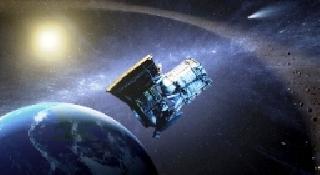
This artist's concept shows the Wide-field Infrared Survey Explorer, or WISE spacecraft, in its orbit around Earth. Photo: NASA/JPL-Caltech
WASHINGTON (PTI): A hibernating NASA spacecraft has been called back into service to identify potentially hazardous near-Earth objects and search asteroids that astronauts could explore.
The spacecraft that discovered and characterised tens of thousands of asteroids throughout the solar system before being placed in hibernation will return to service for three more years starting in September this year.
It will assist NASA in its effort to identify the population of potentially hazardous near-Earth objects, as well as those suitable for asteroid exploration missions.
The Wide-field Infrared Survey Explorer (WISE) will be revived next month with the goal of discovering and characterising near-Earth objects (NEOs), space rocks that can be found orbiting within 45 million kilometres from Earth's path around the Sun, NASA said.
NASA anticipates WISE will use its 40-centimetre telescope and infrared cameras to discover about 150 previously unknown NEOs and characterise the size, albedo and thermal properties of about 2,000 others - including some which could be candidates for the agency's recently announced asteroid initiative.
"The WISE mission achieved its mission's goals and as NEOWISE extended the science even further in its survey of asteroids. NASA is now extending that record of success, which will enhance our ability to find potentially hazardous asteroids, and support the new asteroid initiative," said John Grunsfeld, NASA's associate administrator for science.
NASA's asteroid initiative will be the first mission to identify, capture and relocate an asteroid. It represents an unprecedented technological feat that will lead to new scientific discoveries and technological capabilities that will help protect our home planet.
Launched in December 2009 to look for the glow of celestial heat sources from asteroids, stars and galaxies, WISE made about 7,500 images every day during its primary mission, from January 2010 to February 2011.
As part of a project called NEOWISE, the spacecraft made the most accurate survey to date of NEOs. NASA turned most of WISE's electronics off when it completed its primary mission.
"The data collected by NEOWISE two years ago have proven to be a gold mine for the discovery and characterisation of the NEO population," said Lindley Johnson, NASA's NEOWISE programme executive.
Because asteroids reflect but do not emit visible light, infrared sensors are a powerful tool for discovering, cataloguing and understanding the asteroid population.
 Previous Article
Previous Article Next Article
Next Article












The Indian Air Force, in its flight trials evaluation report submitted before the Defence Ministry l..
view articleAn insight into the Medium Multi-Role Combat Aircraft competition...
view articleSky enthusiasts can now spot the International Space Station (ISS) commanded by Indian-American astr..
view article